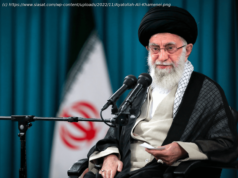The South Korean military was analyzing data to determine the type of missile launched by the North and whether the test was a success.
SEOUL, South Korea — North Korea launched a ballistic missile on Sunday, the first test since a new president took office in South Korea last week and called for dialogue with the North.
The missile took off from the northwestern city of Kusong, and flew more than 430 miles before landing in the sea between North Korea and Japan, the South Korean military said in a statement. Data on the launch was still being analyzed by the South to determine the type of missile.
The United States Pacific Command detected and tracked the missile. Marine Corps Maj. Rob Shuford, a command spokesman, said that flight data indicated that it was not an intercontinental ballistic missile, the type that most concerns the United States.
This was the North’s first missile test since a launch on April 29 that was considered a failure, with the unidentified projectile exploding a few minutes after liftoff.
Under a series of United Nations Security Council resolutions, the country is banned from developing or testing ballistic missiles.
In South Korea, President Moon Jae-in ordered an urgent meeting of top security officials to discuss the launch.
Mr. Moon won the presidential election on Tuesday, bringing South Korean liberals back to power. They favor dialogue with North Korea, saying that sanctions alone have not worked to stop its nuclear and missile threats.
Since taking office on Wednesday, Mr. Moon has said he would be willing to visit North Korea. But he also warned that if the North continued military provocations, it would be difficult to restart dialogue on the divided Korean Peninsula.
North Korea has a history of raising tensions to strengthen its leverage when its foes have proposed negotiations.
Prime Minister Shinzo Abe of Japan strongly protested the action in comments to reporters.
Speaking on Sunday morning, Mr. Abe described the repeated missile launches as a “grave threat against Japan” and vowed to cooperate with the United States and South Korea.
”We maintain a high level of alert to ensure and secure the safety of Japanese nationals, ” he said.
The test on Sunday came one day after a senior North Korean diplomat said her government would be willing to meet with the Trump administration for negotiations “if the conditions are set.”
Choi Sun-hee, the top North Korean diplomat who handles relations with Washington, made the comment in Beijing on Saturday.
Ms. Choi did not elaborate on what the North’s conditions were, but some former American officials and analysts have been considering the possibility of North Korea and the United States returning to negotiations for the first time since 2008, when six-nation talks over the North’s nuclear weapons program fell apart.
President Trump has said he would be “honored” to meet North Korean leader Kim Jong-un under the right circumstances.
In its previous missile test from Kusong, North Korea launched what the Pentagon called “a medium- or intermediate-range ballistic missile” from the Banghyon air base on Feb. 12. The missile flew 310 miles before falling into the sea between North Korea and Japan. The test was conducted as Mr. Trump was hosting Japan’s prime minister, Mr. Abe, on an official visit.
North Korea has been trying to build a reliable intermediate-range ballistic missile, which would be capable of reaching American military bases in the Pacific, including those in Guam.
In a New Year’s Day speech, Mr. Kim said his country had reached a “final stage” in preparing to conduct its first test of an intercontinental ballistic missile.
Although North Korea has vowed to develop the ability to attack the United States with nuclear warheads and has tested missiles that can reach throughout the Korean Peninsula and its vicinity, it has never tested a long-range missile that could fly across the Pacific.
Tensions had appeared to be easing on the Korean Peninsula since joint South Korean-United States military exercises ended late last month without North Korea conducting a nuclear test or launching one of its intercontinental ballistic missiles.




![Atak dronów na Odessę. Siedem osób rannych [RELACJA]](http://nhub.news/wp-content/uploads/2024/04/thumb96406effb1f4d24a03d00548c8241cd1-100x75.jpeg)

